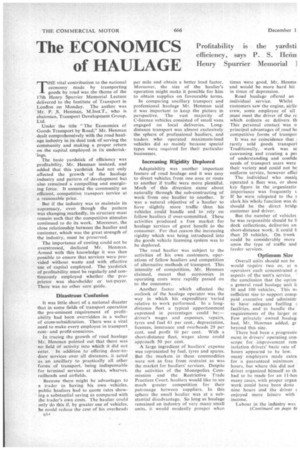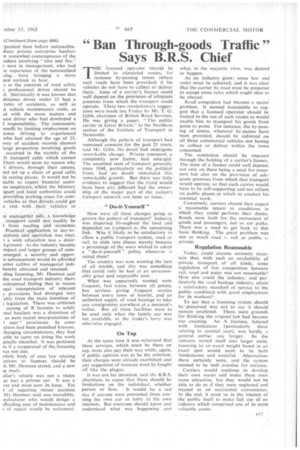The ECONOMICS of HAULAGE
Page 48

Page 51

If you've noticed an error in this article please click here to report it so we can fix it.
Profitability is the yardsti efficiency, says P. S. Helmn Henry Spurrier Memorial ]
THE vital contribution to the national economy made by transporting . goods by road was the theme of the 17th Henry Spurrier Memorial Lecture delivered to the Institute of Transport in London on Monday. The author was Mr. P. ,S, Henman, M.Inst.T., who is chairman, Transport Development Group, Ltd.
Under the title "The Economics of Goods Transport by Road," Mr. Henman dealt comprehensively with the road haulage industry in its dual task of serving the community and making a proper return on the capital employed in its undertakings.
The basic yardstick of efficiency was profitability, Mr. Henman insisted, and added that this yardstick had not only affected the growth of the haulage industry and pattern of development but also remained a compelling and energizing force. It ensured the community an efficient, competitive transport 'service at a reasonable price.
But if the industry was to maintain its supremacy, even though the pattern was changing markedly, its structure must remain such that the competitive stimulus continued to do its work. Moreover, the close relationship between the haulier and customer, which was the great strength of the industry, must be preserved.
The importance of costing could not be overstressed, declared Mr. Henman. Armed with this knowledge it was then possible to ensure that services were provided without waste and with, effective use of capital employed. The yardstick of profitability must be regularly and continuously employed whether the proprietor was shareholder or tax-payer. There was no other sure guide.
Disastrous Confusion
It was little short of a national disaster that in some fields of transport operation the pre-eminent requirement of profitability had been overridden in a welter of cross-subsidization. There was a vital need to make every employee in transport costand profit-conscious.
In tracing the growth of road haulage Mr. Henman pointed out that there was no field of activity into which it did not enter. In addition to offering door-todoor services over all distances, it acted as an ancillary to practically all other forms of transport, being indispensable for terminal services at docks, wharves, railheads and airfields.
Because there might be advantages to a trader in having his own -vehicles, public hauliers had to quote rates show" ing a substantial saving as compared with the trader's own costs. The haulier could only do this if, by greater use of vehicles, he could reduce the cost of his overheads per mile and obtain a better load factor. Moreover, the size of the haulier's operation might make it possible for him to obtain supplies on favourable terms.
In comparing ancillary transport and professional haulage Mr. Henman said it was important to keep the picture in perspective. The vast majority of C-licence vehicles consisted of small vans engaged on local deliveries. Longdistance transport was almost exclusively the sphere of professional hauliers, and traders who operated maximum-load vehicles did so mainly because special types were required for their particular businesses.
Increasing Rigidity Deplored
Adaptability was another important feature of road haulage and it was easy to divert vehicles from one area or route to another if traffic were more plentiful. Much of this diversion came about naturally through the sub-contracting of work from one haulier to another, It was a natural objective of a haulier to have slightly more traffic than his vehicles could handle and to rely on fellow hauliers if over-committed. These activities produced a free market for haulage services of great benefit to the consumer. For that reason the increasing rigidity which was being introduced into the goods vehicle licensing system was to be deplored.
The road haulier was subject to the activities of his own customers, operations of fellow hauliers and competition of alternative methods of transport. This intensity of competition, Mr. Henman claimed, meant that economies in operating costs were rapidly passed on to the consumer, Another factor which affected the outlook of the haulage operator was the way in which his expenditure varied relative to work performed. In a longdistance fleet a typical apportionment expressed in percentages could ' be:--driver's wages and expenses, repairs, tyres and fuel 61 per cent., depreciation, licences, insurance and overheads 29 per cent. and profit 10 per cent. With a short-distance fleet, wages alone could approach 50 per cent.
A large ingredient of hauliers' expense was represented by fuel, tyres and spares. But the markets in these commodities were not as free from restraint as was the market for hauliers' services. Despite the activities of the Monopolies Commission and the Restrictive Trade Practices Court, hauliers would like to see much greater competition for their patronage between suppliers. In this sphere the small haulier was at a substantial disadvantage. So long as haulage remained an industry of very many small units, it would modestly prosper when
times were good, Mr. Henma and would be more hard hit in times of depression. • Road haulage offered an individual service. Whilst customers 'saw the engine, airlir crew, some employee of all must meet the driver of the re which collects or delivers th This personal contact was o principal advantages of road ha competitive forms of transpor
It was no coincidence that rarely sold goods transport Traditionally, work was se canvassing and creating a pet of understanding and confide needs of transport users were their variety and could not be uniform service, however effici The individual who manir operated a fleet was, or shou key figure in the organizatio importance was frequently t If he were relegated to the s clerk his whole function was tic should be the direct bridgi customer and driver.
But the number of vehicles he was responsible should be Ii dock collections, deliveries an short-distance work, it could b than 20 vehicles. On trunk could be considerably more upon the type of traffic and feeder services.
Optimum Size Overall units should not be would require two or, at n operators each concentrated o aspects of the unit's service. the conclusion that the optim a general road haulage unit it 50 and 100 vehicles. This wi sufficient size to sopport comp, paid executive and administr to have adequate fuelling i facilities, and to handle the requirements of the larger or Few privately . owned haulag, had, Mr. Henman added, gr beyond this size.
There had been a progressiv ment in drivers' operating con' scope for improvement rem isolation drivers' basic rate of hours appeared to be low. many employers made extra for a guaranteed minimum hours, but where this did not driver organized himself so th. had to be made for an 11-hot many cases, with proper organ work could have been done nine hours and the driver enjoyed more leisure with income.
Labour in the industry was (Continued on page 64
zanized than before nationalizadany private enterprise hauliers w somewhat contemptuous of the ,7edure involving •" hire and fire."
r men in management, who had le experience of the nationalized King, were bringing a more fled_ Outlook to hear.
s in the interests of road safety professional driver should be d. Statistically it was known that distance driver under 25 had a ratio of accidents, as well as d vehicle maintenance costs, as with the more mature and iced driver who had developed a f responsibility. The community ienefit by limiting employment on Lance driving to experienced who had attained the age of 25. rvey of accident records showed large proportion involving goods
occurred in the vicinity of the ft transport cafés which existed There would seem no reason why .t drivers, through their unions. not set up a chain of good cafés ht. resting Places. It would not be nate to expectfinancial assist
employers, ,Whilst the Ministry Sport and local authorities could providing parking areas for comvehicles so that drivers could get e rest _ with their . vehicles le managerial side, a knowledge transport could not readily be 1 from reading and economic Practical' application to day-to-cedures and operation was vital, a wide education was a &Sirkground: As the industry became i•npact and larger groups of cornemerged, a security and opporir advancement would be afforded oetter calibre of managerial indihereby attracted and retained: • ding licensing, Mr. Henman said the road transport industry there videspread feeling that in recent egal interpretation of relevant y provisions had diverged very ably from the main intention of g legislation. There was criticism issuing of B licences to solely mal hauliers was a distortion of as were recent interpretations of user" provisions. In some oilers had been punished because, :hanging circumstances, they had able to carry on doing the work ginally intended. It was pertinent re if a reappraisal of the, licensing vas not due.
vhofe body of case law relating cti on s to licence S should be d, Mr. Henman stated, and a new tg made.
alier's vehicle was not a status as was a private car. It was a rse and must earn its keep. Yet t of repairing minor accident Mr. Heilman said, was incredible. nufacturer who would design a tffording ease of maintenance and t of repair would he welcomed.




















































































































